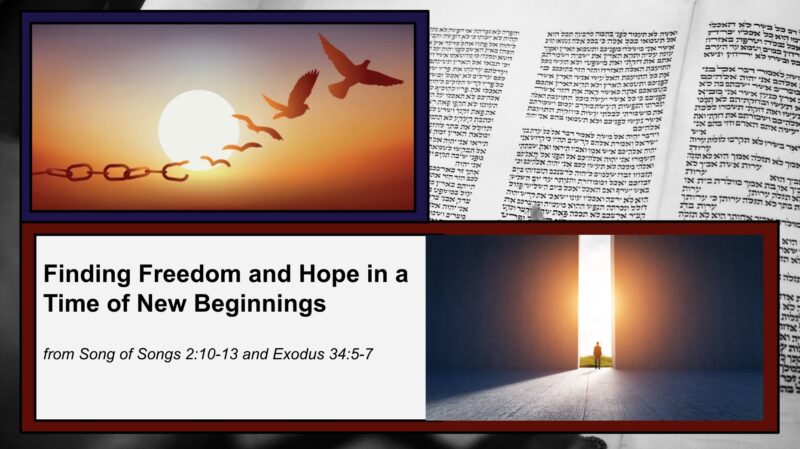Guest Post: “Finding Freedom and Hope in a Time of New Beginnings”
This guest post is from cantorial soloist and CBI member Ziva Larson, who led Shabbat and Pesach services this past weekend.
This week, we began observing the Festival of Pesach, of Passover, also known as z’man cheiruteinu (זְמַן חֵרוּתֵנוּ), the season of our freedom.
Pesach falls during the Hebrew month of Nisan (נִיסָן). Nisan, which the Torah refers to as chodesh ha-aviv (חֹדֶשׁ הָאָבִיב) – “the springtime month,” marks the beginning of the spring season.
The passage we read this morning from Shir HaShirim, or Song of Songs, is full of explicit references to spring: winter is past, plants are flowering, fruits are beginning to form, and birds are returning. There is even a reference to the end of the rainy season. While this last reference applies to the biblical land of Israel, where a rainy season spans the winter months, rather than to our weather patterns here in the northeast of the United States, the concept of a change in the weather as we enter a new season – a season of new beginnings – still applies. For us, it’s just a change from cold weather and snow to warmer temperatures and rain rather than a change from the rainy season to the dry season (where the only moisture available might be dew).
This change in seasonal weather is even reflected in our liturgy. In the prayer “G’vurot” (גְּבוּרוֹת), or “Might,” which is the second prayer in the Amidah, a single line changes. From Shemini Atzeret (which immediately follows Sukkot) until Pesach, we recite “Mashiv haruach u’morid hagashem.” (מַשִׁיב הָרוּחַ וּמוֹרִיד הַגָּשֶׁם) – “You [God] cause the wind to shift and rain to fall.” However, beginning with Pesach and continuing until Shemini Atzeret, we recite “Morid hatal.” (מוֹרִיד הַטַּל) – “You [God] rain dew upon us.”
How beautiful and meaningful it is that our liturgy helps us notice and reflect upon the changes in the natural world around us!
Moreover, many of our holiday traditions (such as reading Shir HaShirim during Pesach) also draw our attention to changes in our environment as well as providing us with opportunities for self-exploration and growth through imagery from the natural world that can be understood in metaphorical ways.
For example, the changing of the seasons from winter to spring represents a time for new beginnings. There is also a reference to the arrival of a dove. A dove commonly symbolizes love, faithfulness, and longevity; harmony; hope; a messenger of peace; and, again, new beginnings. Finally, the reference to “a time of pruning” signifies a time for righting wrongs, for working to fix mistakes, and for working to make the world a better place so that future generations will not have to deal with the consequences of our actions or inaction.
This brings us directly to our Torah portion for today, Exodus 34:5-7. Some of you may have recognized many of the words in these verses. We recite an excerpt of these verses as part of our liturgy at certain times during the Jewish year – for example, during the High Holy Days. The excerpt we recite is known as Sh’losh Esrei Midot (שְׁלוֹשׁ־עֶשְׂרֵה מִידּוֹת) or The Thirteen Attributes – a list of thirteen attributes of God:
“Adonai, Adonai, Eil rachum v’chanun erech apayim v’rav chesed ve’emet; notzeir chesed la’alafim, nosei avon va-fesha v’chata’ah v’nakeih […].”
יְהֹוָה יְהֹוָה אֵל רַחוּם וְחַנּוּן אֶרֶךְ אַפַּיִם וְרַב־חֶסֶד וֶאֱמֶת׃
נֹצֵר חֶסֶד לָאֲלָפִים נֹשֵׂא עָוֹן וָפֶשַׁע וְחַטָּאָה וְנַקֵּה […]
“!יהוה! יהוה – a God compassionate and gracious, slow to anger, abounding in kindness and faithfulness, extending kindness to the thousandth generation, forgiving iniquity, transgression, and sin […]”
These words on their own offer a very positive portrayal of God. However, in their original context in Torah, the portrayal is much more nuanced and, depending on how you interpret it, disturbing.
In Torah, after outlining these thirteen positive attributes of God, the verse continues by saying that God “[does not remit] all punishment, but [visits] the iniquity of parents upon children and children’s children, upon the third and fourth generations.”
[…] לֹא יְנַקֶּה פֹּקֵד עֲוֹן אָבוֹת עַל־בָּנִים וְעַל־בְּנֵי בָנִים עַל־שִׁלֵּשִׁים וְעַל־רִבֵּעִים.
“[…] lo y’nakeh pokei avon avot al banim v’al b’nei vanim al shileishim v’al ribei’im.”
This paints a very different picture than the initial thirteen attributes – one that, at first glance, is incredibly disturbing and confusing. How can God be compassionate, kind, patient, and forgiving while simultaneously punishing future generations for the mistakes of their ancestors? So many things about that picture feel wrong.
So how can we understand this part of the verse, both alone and in relation to the thirteen attributes that come before?
Perhaps instead of saying that future generations will be punished for the mistakes of their ancestors, this part of the verse is instead saying something slightly different. Perhaps the idea of the iniquity of ancestors being visited upon future generations means that future generations will have to deal with the consequences of the damage we current generations are inflicting upon the world and each other. God is not directly punishing future generations for our mistakes. Rather, we – the current generations – are responsible for how our actions or inaction will impact future generations.
This interpretation, while still serious, is much more hopeful and even potentially liberating. It means that we are not trapped and that future generations are not doomed to suffer. If we dedicate ourselves to righting wrongs, working to fix mistakes, and working to make the world a better place, future generations will not be subjected to the consequences of the damage currently being inflicted upon the world and one other. Of course, no one is perfect – we all make mistakes. But if we are consistent in our efforts to do the right thing, we can make a difference.
As we learned from our Shir HaShirim verses today, now – the beginning of springtime and the Festival of Pesach – is a time for new beginnings. It is also a time for clearing out chameitz (חָמֵץ).
If this term is unfamiliar, the literal definition of chameitz is: food with leavening agents (as opposed to food like matzah, which does not have leavening agents and is very basic and simple). During Pesach, a traditional practice is to eat matzah and avoid chameitz. Matzah can be understood as that which is most basic in our lives. Therefore, in a way, observing Pesach in this manner provides us with an opportunity to step away from or get rid of everything except the most basic or simple things – and not just in terms of food. Metaphorically and more broadly, clearing out chameitz can mean clearing out the “extra stuff” or baggage in our lives that distracts us from what is important in life.
And, by removing the distracting “extra stuff” in our lives and liberating ourselves from our baggage, we give ourselves the space and the freedom to focus on the important things, such as working to make the world a better place – both for the benefit of all people currently alive as well as for the benefit of future generations.
So, as we transition into springtime – a time of new beginnings – and observe the Festival of Pesach – this season of freedom, I invite us all to consider a few questions:
- How might we each give ourselves the gift of freedom by clearing out the chameitz – the “extra stuff” – in our lives?
- How might the clearing out of chameitz in our own lives enable each of us to work to give others the gift of freedom?
- How might we begin now to work to make the world a better place and, in doing so, give future generations the gift of freedom from the consequences of our mistakes?
May we all be blessed with freedom from the “extra stuff” in our lives, with new beginnings whenever we need them, with harmony and peace, and with hope for the future.
Shabbat shalom and Chag Pesach sameach.
References
-
- Sefaria:
- Shir HaShirim / Song of Songs 2:10-13: https://www.sefaria.org/Song_of_Songs.2.10-13?lang=bi
- Shemot / Exodus 34:5-7: https://www.sefaria.org/Exodus.34.5-7?lang=bi&aliyot=0
- Liturgy:
- “G’vurot,” Festival Morning Service – Mishkan T’filah p. 472 (complete siddur) or p. 208 (weekdays and festivals volume)
- Sefaria:
- “Hashem, Hashem (הי הי)” – The Encyclopedia of Jewish Prayer by Macy Nulman, pp. 159-160
- “Spiritual Hametz” by Rabbi Kerry M. Olitzky – My Jewish Learning: https://www.myjewishlearning.com/article/spiritual-hametz/
- “The Month of Nisan” – Orthodox Union: https://www.ou.org/holidays/chodesh_nisan/
- Dove Symbolism:
- “The Sweet Symbolism and Spiritual Meaning of Doves” – BahaiTeachings.org https://bahaiteachings.org/sweet-symbolism-spiritual-meaning-doves/
- “Turtle Dove Spiritual Meaning” – SpiritualDesk.com: https://spiritualdesk.com/turtle-dove-spiritual-meaning/
This is the d’var Torah that cantorial soloist and CBI member Ziva Larson offered at Shabbat and Pesach services this past weekend.


![Pesach Shabbat D'var Torah Image 2_4 (2023.04.08) [Image description for accessibility: Image collage related to Song of Songs 2:10-13. The images are (beginning at top left and going clockwise): 1) A picture looking up at a circle of people of various ages, genders, and ethnicities creating a star with their fingers in a “v” shape for peace. The people are looking down at the camera through their finger-star. 2) A blurry hand in the background holds a smooth, bright yellow rock in the foreground that has the word “hope” written on it. 3) The background is a golden brown that is lighter in the middle than on the side edges. The foreground contains a small green plant planted in dark soil that covers the entire bottom of the picture. Above the plant are the words “New Beginnings.” 4) A dove sits on a horizontal tree branch. The background is blurry green leaves and branches. 5) A white-skinned hand holds a pair of pruning shears and is about to clip off the end of a branch with green leaves. The background is blurry green leaves and white light spots. 6) The background is a watercolor mixture of pink, purple, blue, turquoise, and green. The foreground has a pair of hands clasped together, both paper-white and outlined in blue. Below the hands are the words “Together with differences and diversity.” 7) The left side of the picture depicts the left half of a deciduous tree in winter with the branches and the ground covered in snow. The right side of the picture depicts the right half of a deciduous tree in spring with the branches covered with pink flowers, the ground covered with green grass and pink flowers, and butterflies and birds in the air.]](https://cbiberkshires.com/wp-content/uploads/2023/04/Pesach-Shabbat-Dvar-Torah-Image-2_4-2023.04.08.jpg)
![Pesach Shabbat D'var Torah Image 3_4 (2023.04.08) [Image description for accessibility: Image collage related to Exodus 34:5-7. The images are (beginning at top left and going mostly clockwise): 1) A white box with a black border containing the words “YHVH, YHVH, compassion and tenderness, patience, forbearance, lovingkindness, awareness. Bearing love from age to age, lifting guilt and mistakes and making us free.” 2a) An assortment of breads and rolls. 2b) Located right below image 2a - three pieces of matzah resting on a lacy white tablecloth. 3) Located to the right of images 2a and 2b - a person with a feathered hat stands hunched over at the edge of a train platform. The sky behind them is filled with dark gray clouds. They have several bags and packages on their back and are carrying several more in their hands. A large stack of additional baggage stretches out behind them. 4a) Located right below images 2a, 2b, and 3 - A silhouetted person stands looking into the sunrise. Their hands are raised above their head. Chains are attached to each wrist, but the chain has been broken in the middle. 4b) Located to the right of image 4a - The background is a pile of overturned (blank) Scrabble tiles. The foreground is the word “hope” spelled out in Scrabble tiles. 5a) Located below image 4b - A white box with a black border contains a blue globe with green continents in the bottom right corner. In the top right corner are the words “Repair the world/Tikkun olam.” 5b) Located to the left of image 5a - The background is a blurry blue landscape of a lake with mountains behind it. The foreground shows the hands, wrists, and head of a person wearing a blue hooded shirt. From their outstretched open hands, a collection of small, soft spheres of light are floating away into the distance. 6) Located to the left of image 5b - A black box contains white text that says, “ We are responsible for how our actions or inaction will impact future generations.” 7a) Located above image 6 - A cardboard sign says, “Fight today for a better tomorrow.” It is being held above the heads of a group of people. Other heads and signs are visible - although blurred - in the background. 7b) Located to the right of image 7a - The background is a blurred image of a green grassy area bordered by darker green deciduous trees. The foreground shows a pair of light brown, larger/adult hands cupping a pair of dark brown, smaller/child hands, which are cupping a small plant rooted in a small pile of dark soil.]](https://cbiberkshires.com/wp-content/uploads/2023/04/Pesach-Shabbat-Dvar-Torah-Image-3_4-2023.04.08.jpg)
![Pesach Shabbat D'var Torah Image 4_4 (2023.04.08) [Image description for accessibility: The background is a colorful, bright, abstract painting of a tree using lots of circles and leaf shapes. In the bottom right corner of the image is white text that says, “Artwork by LuizaVizoliArt.” In the foreground are three horizontal yellow rectangles with black borders and black text. They are stacked vertically from top to bottom with some space in between and around each of them through which the background image is visible. The shade of yellow is lightest in the top box and darkest in the bottom box. The text in each of the boxes is as follows: Box 1: 1) How might we each give ourselves the gift of freedom by clearing out the chameitz - the “extra stuff” - in our lives? Box 2: 2) How might the clearing out of chameitz in our own lives enable each of us to work to give others the gift of freedom? Box 3: 3) How might we begin now to work to make the world a better place and, in doing so, give future generations the gift of freedom from the consequences of our mistakes?]](https://cbiberkshires.com/wp-content/uploads/2023/04/Pesach-Shabbat-Dvar-Torah-Image-4_4-2023.04.08.jpg)




